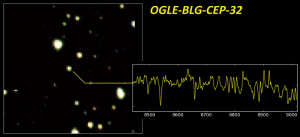First stars found in flare of Milky Way Cepheid variable stars may be guide to dark matter around Milky Way

Our galaxy has a disk, known as the Milky Way, in which most stars and interstellar gas are concentrated. Previous observations of interstellar gas have suggested that the disk has a flare towards the outer part; i.e. the outer part of the disk is the thicker. However, it was not known whether stars were associated with the flared part or how any such stars were distributed.

© 2014 Feast, Menzies, Matsunaga, & Whitelock.
An infrared image (left) of one of the first stars identified in the flared outer disk of the Milky Way, named OGLE-BLG-CEP-32, together with its spectrum (insert right).
Assistant Professor Noriyuki Matsunaga at the University of Tokyo and Honorary Professor Michael W. Feast at the University of Cape Town and their research group have identified the first stars which belong to the flared part of the Milky Way. These stars were reported to be Cepheid variable stars, and the research team measured their distances making use of the period-luminosity relation which is well-known as a method of measuring distances to this particular type of variable star. The stars were found to be at distances of 60?100 thousand light years from the Sun and located in the constellations of Sagittarius and Ophiuchus. All of the stars are located more than 3,000 light years from the Milky Way, greatly differing from other Cepheid variable stars discovered to date, all of which are located within 1,000 light years vertically of the plane of the galactic disk.
Because it is thought that the flare in the outer part of the Milky Way is dominated by dark matter, the Cepheid variable stars discovered and other stars to be discovered in the future may be a good tracer of the distribution of dark matter around our galaxy.
Press release (Japanese)
Paper
Michael W. Feast, John W. Menzies, Noriyuki Matsunaga & Patricia A. Whitelock,
“Cepheid variables in the flared outer disk of our galaxy”,
Nature Online Edition: 2014/5/22, doi: 10.1038/nature13246.
Article link
Links
Department of Astronomy, Graduate School of Science






